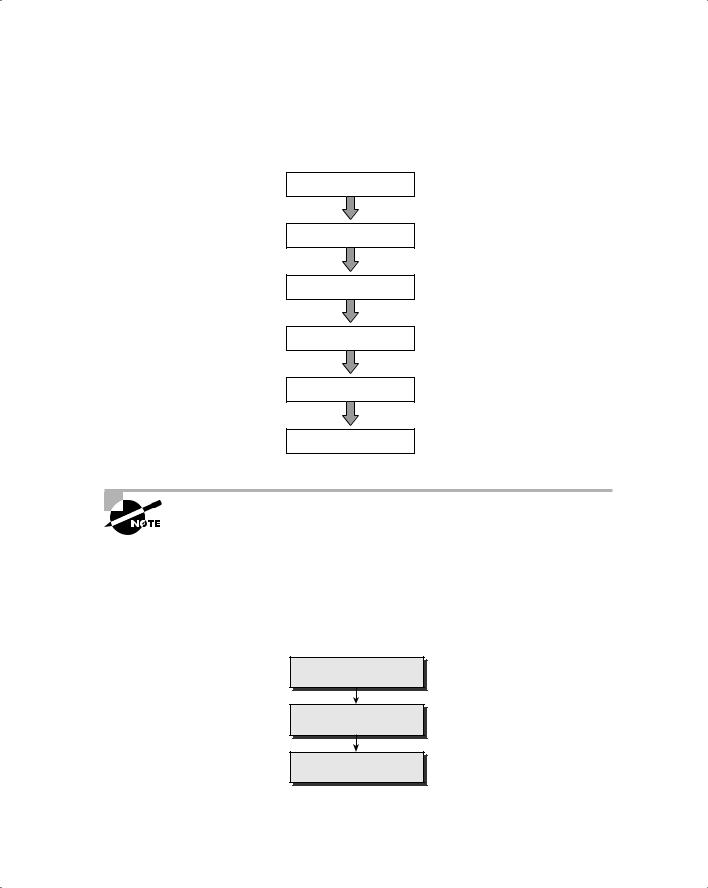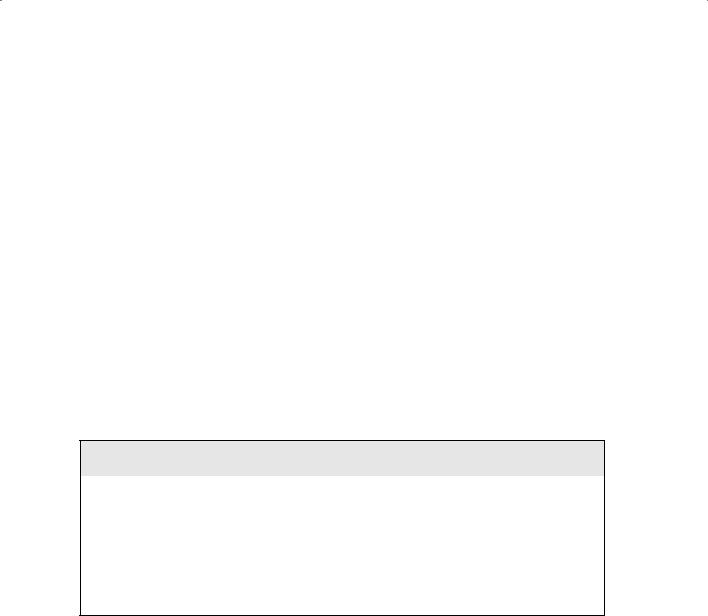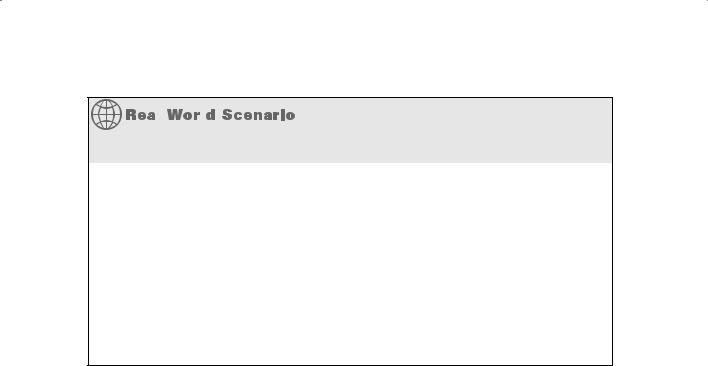
- •Acknowledgments
- •About the Author
- •Contents at a Glance
- •Contents
- •Table of Exercises
- •Introduction
- •Assessment Test
- •Answers to Assessment Test
- •Defining Ethical Hacking
- •How to Be Ethical
- •Keeping It Legal
- •Summary
- •Exam Essentials
- •Review Questions
- •Answers to Review Questions
- •Reconnaissance
- •Information-Gathering Methodology
- •Social Engineering
- •Summary
- •Exam Essentials
- •Review Questions
- •Answers to Review Questions
- •Scanning
- •Enumeration
- •Summary
- •Exam Essentials
- •Review Questions
- •Answers to Review Questions
- •The Simplest Way to Get a Password
- •Types of Passwords
- •Cracking a Password
- •Understanding Keyloggers and Other Spyware Technologies
- •Escalating Privileges
- •Understanding Rootkits
- •Hiding Files
- •Understanding Steganography Technologies
- •Summary
- •Exam Essentials
- •Review Questions
- •Answers to Review Questions
- •Trojans and Backdoors
- •Viruses and Worms
- •Summary
- •Exam Essentials
- •Review Questions
- •Answers to Review Questions
- •How a Sniffer Works
- •Sniffing Countermeasures
- •Bypassing the Limitations of Switches
- •Wireshark Filters
- •Summary
- •Exam Essentials
- •Review Questions
- •Answers to Review Questions
- •Denial of Service
- •Session Hijacking
- •Summary
- •Exam Essentials
- •Review Questions
- •Answers to Review Questions
- •How Web Servers Work
- •Types of Web Server Vulnerabilities
- •Web Application Vulnerabilities
- •Summary
- •Exam Essentials
- •Review Questions
- •Answers to Review Questions
- •SQL Injection
- •Buffer Overflows
- •Summary
- •Exam Essentials
- •Review Questions
- •Answers to Review Questions
- •Wi-Fi and Ethernet
- •Authentication and Cracking Techniques
- •Using Wireless Sniffers to Locate SSIDs
- •MAC Filters and MAC Spoofing
- •Rogue Access Points
- •Wireless Hacking Techniques
- •Securing Wireless Networks
- •Summary
- •Exam Essentials
- •Review Questions
- •Answers to Review Questions
- •Components of Physical Security
- •Understanding Physical Security
- •Physical Site Security Countermeasures
- •What to Do After a Security Breach Occurs
- •Summary
- •Exam Essentials
- •Review Questions
- •Answers to Review Questions
- •Linux Basics
- •Compiling a Linux Kernel
- •GCC Compilation Commands
- •Installing Linux Kernel Modules
- •Linux Hardening Methods
- •Summary
- •Exam Essentials
- •Review Questions
- •Answers to Review Questions
- •Types of IDSs and Evasion Techniques
- •Summary
- •Exam Essentials
- •Review Questions
- •Answers to Review Questions
- •Generating Public and Private Keys
- •Cryptography Algorithms
- •Summary
- •Exam Essentials
- •Review Questions
- •Answers to Review Questions
- •Defining Security Assessments
- •Penetration Testing
- •Pen Test Deliverables
- •Summary
- •Exam Essentials
- •Review Questions
- •Answers to Review Questions
- •Glossary
- •Index

16 Chapter 1 n Introduction to Ethical Hacking, Ethics, and Legality
Ethical Hacking Report
The result of a network penetration test or security audit is an ethical hacking, or pen test report. Either name is acceptable, and they can be used interchangeably. This report details the results of the hacking activity, the types of tests performed, and the hacking methods used. The results are compared against the expectations initially agreed upon with the customer. Any vulnerabilities identified are detailed, and countermeasures are suggested. This document is usually delivered to the organization in hard-copy format, for security reasons. The details of the ethical hacking report must be kept confidential, because they high-
light the organization’s security risks and vulnerabilities. If this document falls into the wrong hands, the results could be disastrous for the organization. It would essentially give someone the roadmap to all the security weaknesses of an organization.
How to Be Ethical
Ethical hacking is usually conducted in a structured and organized manner, usually as part of a penetration test or security audit. The depth and breadth of the systems and applications to be tested are usually determined by the needs and concerns of the client. Many ethical hackers are members of a tiger team. A tiger team works together to perform a full-scale test covering all aspects of network, physical, and systems intrusion.
The ethical hacker must follow certain rules to ensure that all ethical and moral obligations are met. An ethical hacker must do the following:
NNGain authorization from the client and have a signed contract giving the tester permission to perform the test.
NNMaintain and follow a nondisclosure agreement (NDA) with the client in the case of confidential information disclosed during the test.
NNMaintain confidentiality when performing the test. Information gathered may contain sensitive information. No information about the test or company confidential data should ever be disclosed to a third party.
NNPerform the test up to but not beyond the agreed-upon limits. For example, DoS attacks should only be run as part of the test if they have previously been agreed upon with the client. Loss of revenue, goodwill, and worse could befall an organization whose servers or applications are unavailable to customers as a result of the testing.
The following steps (shown in Figure 1.4) are a framework for performing a security audit of an organization and will help to ensure that the test is conducted in an organized, efficient, and ethical manner:
1.Talk to the client, and discuss the needs to be addressed during the testing.
2.Prepare and sign NDA documents with the client.
3.Organize an ethical hacking team, and prepare a schedule for testing.
4.Conduct the test.

How to Be Ethical |
17 |
5.Analyze the results of the testing, and prepare a report.
6.Present the report findings to the client.
F i g u r e 1. 4 Security audit steps
Initial Client Meeting
Sign NDA with Client
Security Evaluation Plan
Conduct the Test
Report and Documentation
Present Report Findings
In-depth penetration testing and security auditing information is discussed in EC-Council’s Licensed Penetration Tester (LPT) certification.
Performing a Penetration Test
Many ethical hackers acting in the role of security professionals use their skills to perform security evaluations or penetration tests. These tests and evaluations have three phases, generally ordered as follows:
Preparation
Conduct Security Evaluation
Conclusion

18 Chapter 1 n Introduction to Ethical Hacking, Ethics, and Legality
Preparation This phase involves a formal agreement between the ethical hacker and the organization. This agreement should include the full scope of the test, the types of attacks (inside or outside) to be used, and the testing types: white, black, or gray box.
Conduct Security Evaluation During this phase, the tests are conducted, after which the tester prepares a formal report of vulnerabilities and other findings.
Conclusion The findings are presented to the organization in this phase, along with any recommendations to improve security.
Notice that the ethical hacker does not “fix” or patch any of the security holes they may find in the target of evaluation. This is a common misconception of performing security audits or penetration tests. The ethical hacker usually does not perform any patching or implementation of countermeasures. The final goal or deliverable is really the findings of the test and an analysis of the associated risks. The test is what leads to the findings in the final report and must be well documented.
Contrary to popular belief, ethical hackers performing a penetration test must be very organized and efficient, and they must document every finding by taking screenshots, copying the hacking tool output, or printing important log files. Ethical hackers must be very professional and present a well-documented report to be taken seriously in their profession. More information on performing a penetration test can be found in Chapter 15, “Performing a Penetration Test.”
Defining Hacktivism
Hacktivism refers to hacking for a cause. These hackers usually have a social or political agenda. Their intent is to send a message through their hacking activity while gaining visibility for their cause and themselves.
Many of these hackers participate in activities such as defacing websites, creating viruses, and implementing DoS or other disruptive attacks to gain notoriety for their cause. Hacktivism commonly targets government agencies, political groups, and any other entities these groups or individuals perceive as “bad” or “wrong.”
Keeping It Legal
An ethical hacker should know the penalties of unauthorized hacking into a system. No ethical hacking activities associated with a network-penetration test or security audit should begin until a signed legal document giving the ethical hacker express permission to perform the hacking activities is received from the target organization. Ethical hackers need to be judicious with their hacking skills and recognize the consequences of misusing those skills.

|
Keeping It Legal |
19 |
|
|
|
|
|
|
Hacking Attempt Liability
A website operated by a securities brokerage firm suffers a hacking attack. As a result of the attack, the firm’s customers are unable to conduct trades for several hours. On the day of the attack, the stock market is volatile, and many customers are trying unsuccessfully to buy or sell stocks. The customers are very unhappy and blame the firm for failing to prevent, detect, and recover from the attack.
In this situation, the hackers are the ones to blame. But what about the brokerage firm itself? Customers are relying on the firm’s website to make trades. Are the brokerage firm and their network providers vulnerable to a lawsuit from unhappy clients who lost money as a result of the shutdown? Does the brokerage firm have any liability because they were unable to prevent the shutdown of the website-driven trading system? Some of the laws discussed in this chapter will address this issue of liability after hacking attacks.
Computer crimes can be broadly categorized into two categories: crimes facilitated by a computer and crimes where the computer is the target.
The most important U.S. laws regarding computer crimes are described in the following sections. Although the CEH exam is international in scope, make sure you familiarize yourself with these U.S. statutes and the punishment for hacking. Remember, intent doesn’t make a hacker above the law; even an ethical hacker can be prosecuted for breaking these laws.
Cyber Security Enhancement Act and SPY ACT
The Cyber Security Enhancement Act of 2002 mandates life sentences for hackers who “recklessly” endanger the lives of others. Malicious hackers who create a life-threatening situation by attacking computer networks for transportation systems, power companies, or other public services or utilities can be prosecuted under this law.
The Securely Protect Yourself Against Cyber Trespass Act of 2007 (SPY ACT) deals with the use of spyware on computer systems and essentially prohibits the following:
NN |
Taking remote control of a computer when you have not been authorized to do so |
|
NNUsing a computer to send unsolicited information to people (commonly known as spamming)
NN |
Redirecting a web browser to another site that is not authorized by the user |
NNDisplaying advertisements that cause the user to have to close out of the web browser (pop-up windows)
NN |
Collecting personal information using keystroke logging |

20 Chapter 1 n Introduction to Ethical Hacking, Ethics, and Legality
NN |
Changing the default web page of the browser |
NNMisleading users so they click on a web page link or duplicating a similar web page to mislead a user
The SPY ACT is important in that it starts to recognize annoying pop-ups and spam as more than mere annoyances and as real hacking attempts. The SPY ACT lays a foundation for prosecuting hackers that use spam, pop-ups, and links in emails.
18 USC §1029 and 1030
The U.S. Code categorizes and defines the laws of the United States by titles. Title 18 details “Crimes and Criminal Procedure.” Section 1029, “Fraud and related activity in connection with access devices,” states that if you produce, sell, or use counterfeit access devices or telecommunications instruments with intent to commit fraud and obtain services or products with a value over $1,000, you have broken the law. Section 1029 criminalizes the misuse of computer passwords and other access devices such as token cards.
Section 1030, “Fraud and related activity in connection with computers,” prohibits accessing protected computers without permission and causing damage. This statute criminalizes the spreading of viruses and worms and breaking into computer systems by unauthorized individuals.
The full text of the Section 1029 and 1030 laws is included as an appendix in this book for your reference.
U.S. State Laws
In addition to federal laws, many states have their own laws associated with hacking and auditing computer networks and systems. When performing penetration testing, review the applicable state laws to ensure that you are staying on the right side of the law. In many cases, a signed testing contract and NDA will suffice as to the intent and nature of the testing.
The National Security Institute has a website listing all the state laws applicable to computer crimes. The URL is
http://nsi.org/Library/Compsec/computerlaw/statelaws.html
Federal Managers Financial Integrity Act
The Federal Managers Financial Integrity Act of 1982 (FMFIA) is basically a responsibility act to ensure that those managing financial accounts are doing so with the utmost

Keeping It Legal |
21 |
responsibility and are ensuring the protection of the assets. This description can be construed to encompass all measurable safeguards to protect the assets from a hacking attempt. The act essentially ensures that
NNFunds, property, and other assets are safeguarded against waste, loss, unauthorized use, or misappropriation.
NN |
Costs are in compliance with applicable laws. |
The FMFIA is important to ethical hacking as it places the responsibility on an organization for the appropriate use of funds and other assets. Consequently, this law requires management to be responsible for the security of the organization and to ensure the appropriate safeguards against hacking attacks.
Freedom of Information Act (FOIA)
The Freedom of Information Act (5 USC 552), or FoIA, makes many pieces of information and documents about organizations public. Most records and government documents can be obtained via the FoIA. Any information gathered using this act is fair game when you are performing reconnaissance and information gathering about a potential target.
Federal Information Security Management Act (FISMA)
The Federal Information Security Management Act (FISMA) basically gives ethical hackers the power to do the types of testing they perform and makes it a mandatory requirement for government agencies.
FISMA requires that each federal agency develop, document, and implement an agencywide information security program to provide information security for the information and information systems that support the operations and assets of the agency, including those provided or managed by another agency, contractor, or other source. The information security program must include the following:
NNPeriodic assessments of the risk and magnitude of the harm that could result from the unauthorized access, use, disclosure, disruption, modification, or destruction of information and information systems that support the operations and assets of the agency
NNPolicies and procedures that are based on risk assessments, cost-effectively reduce information security risks to an acceptable level, and ensure that information security is addressed throughout the life cycle of each agency information system
NNSubordinate plans for providing adequate information security for networks, facilities, information systems, or groups of information systems, as appropriate
NNSecurity awareness training to inform personnel (including contractors and other users of information systems that support the operations and assets of the agency) of the information security risks associated with their activities and their responsibilities in complying with agency policies and procedures designed to reduce these risks

22 Chapter 1 n Introduction to Ethical Hacking, Ethics, and Legality
NNPeriodic testing and evaluation of the effectiveness of information security policies, procedures, and practices (including the management, operational, and technical controls of every agency information system identified in their inventory) with a frequency depending on risk, but no less than annually
NNA process for planning, implementing, evaluating, and documenting remedial action to address any deficiencies in the information security policies, procedures, and practices of the agency
NNProcedures for detecting, reporting, and responding to security incidents (including mitigating risks associated with such incidents before substantial damage is done and notifying and consulting with the federal information security incident response center, and as appropriate, law enforcement agencies, relevant Offices of Inspector General, and any other agency or office, in accordance with law or as directed by the President
NNPlans and procedures to ensure continuity of operations for information systems that support the operations and assets of the agency
This act is guaranteed job security for ethical white hat hackers to perform continual security audits of government agencies and other organizations.
Privacy Act of 1974
The Privacy Act of 1974 (5 USC 552a) ensures nondisclosure of personal information and ensures that government agencies are not disclosing information without the prior written consent of the person whose information is in question.
USA PATRIOT Act
This act, with the official name Uniting and Strengthening America by Providing Appropriate Tools Required to Intercept and Obstruct Terrorism (USA PATRIOT) Act of 2001, gives the government the authority to intercept voice communications in computer hacking and other types of investigations. The Patriot Act was enacted primarily to deal with terrorist activity but can also be construed as a wiretap mechanism to discover and prevent hacking attempts.
Government Paperwork Elimination Act (GPEA)
The Government Paperwork Elimination Act (GPEA) of 1998 requires federal agencies to allow people the option of using electronic communications when interacting with a government agency. GPEA also encourages the use of electronic signatures. When valuable government information is stored in electronic format, the targets and stakes for hackers is increased.
